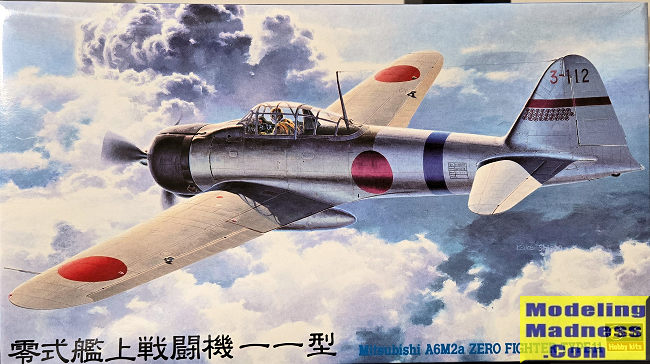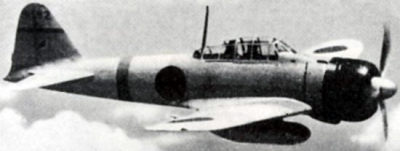
| KIT #: | 09142 (Jt42) |
| PRICE: | 2200 yen when new |
| DECALS: | Four options |
| REVIEWER: | Scott Van Aken |
| NOTES: | 1996 release |

| HISTORY |
While the Navy was testing the first two prototypes, they suggested that the third be fitted with the 700 kW (940 hp) Nakajima Sakae 12 engine instead. Mitsubishi had its own engine of this class in the form of the Kinsei, so they were somewhat reluctant to use the Sakae. Nevertheless, when the first A6M2 was completed in January 1940, the Sakae's extra power pushed the performance of the Zero well past the original specifications.
The new version was so promising that the Navy had 15 built and shipped to China before they had completed testing. They arrived in Manchuria in July 1940, and first saw combat over Chongqing in August. There they proved to be completely untouchable by the Polikarpov I-16s and I-153s that had been such a problem for the A5Ms when in service. In one encounter, 13 Zeros shot down 27 I-15s and I-16s in under three minutes without loss. After hearing of these reports, the Navy immediately ordered the A6M2 into production as the Type 0 Carrier Fighter, Model 11. Reports of the Zero's performance slowly filtered back to the US. They were met with skepticism by most US military officials, who thought it impossible for the Japanese to build such an aircraft. 65 type 11 aircraft were built before production switched over to the type 21.
| THE KIT |
 In
the mid-1990s, Hasegawa embarked on a program to produce the full line of A6M
kits in 1/48 scale. This was accomplished by using a few common sprues and then
adding in those items that would make the variant to be kitted. This is pretty
standard stuff for Hasegawa and some other model companies. Newer companies,
such as Eduard, include all the parts to do multiple variants in each kit and
have you use only those bits to build the version being boxed. Both methods have
their plusses and minuses.
In
the mid-1990s, Hasegawa embarked on a program to produce the full line of A6M
kits in 1/48 scale. This was accomplished by using a few common sprues and then
adding in those items that would make the variant to be kitted. This is pretty
standard stuff for Hasegawa and some other model companies. Newer companies,
such as Eduard, include all the parts to do multiple variants in each kit and
have you use only those bits to build the version being boxed. Both methods have
their plusses and minuses.
This kit allows you to build the earliest production A6M2a which can be differentiated by the somewhat different rear canopy treatment. In addition, these early planes were not equipped with tail hooks, being land based, so not needing them. Since Hasegawa does use a modular style with their A6M kits, there are some panel lines that will need to be filled, and a few features to be removed. Nothing major and fairly easy to accomplish.
The kit's interior is nicely done and you are provided with a decal for instruments. About the only thing that the cockpit really needs is a seat belt. Note that these planes did not have a shoulder harness and in fact, some pilots felt that even the belt restrained their freedom of movement so did not wear them.
There are no optional bits on this one, making for a very simple build. Some of the other features include a prop with separate blades and a blanking plate for the arresting gear well. The canopy can be posed open if you so desire.

 Instructions
are standard fare with Gunze paint references. There are four markings options,
all the early production planes based in China with the 12th Flying Group. Three
of these planes have a slightly darker forward fuselage/wings compared to the
rear of the aircraft. This is visible in this photo from the 'net. The decal
sheet is nicely printed and is just beginning to yellow, which isn't bad after
30 years. Even after all this time, I'm sure the sheet is still viable. There
are, of course, aftermarket options if you so wish them.
Instructions
are standard fare with Gunze paint references. There are four markings options,
all the early production planes based in China with the 12th Flying Group. Three
of these planes have a slightly darker forward fuselage/wings compared to the
rear of the aircraft. This is visible in this photo from the 'net. The decal
sheet is nicely printed and is just beginning to yellow, which isn't bad after
30 years. Even after all this time, I'm sure the sheet is still viable. There
are, of course, aftermarket options if you so wish them.
| CONCLUSIONS |
Even with newer tooling kits of the early A6M from Tamiya and Eduard, this one is by no means 'obsolete' and will build into a nice model.
August 2024
Copyright ModelingMadness.com. All rights reserved. No reproduction in part or in whole without express permission from the editor.
If you would like your product reviewed fairly and fairly quickly, please contact the editor or see other details in the Note to Contributors.